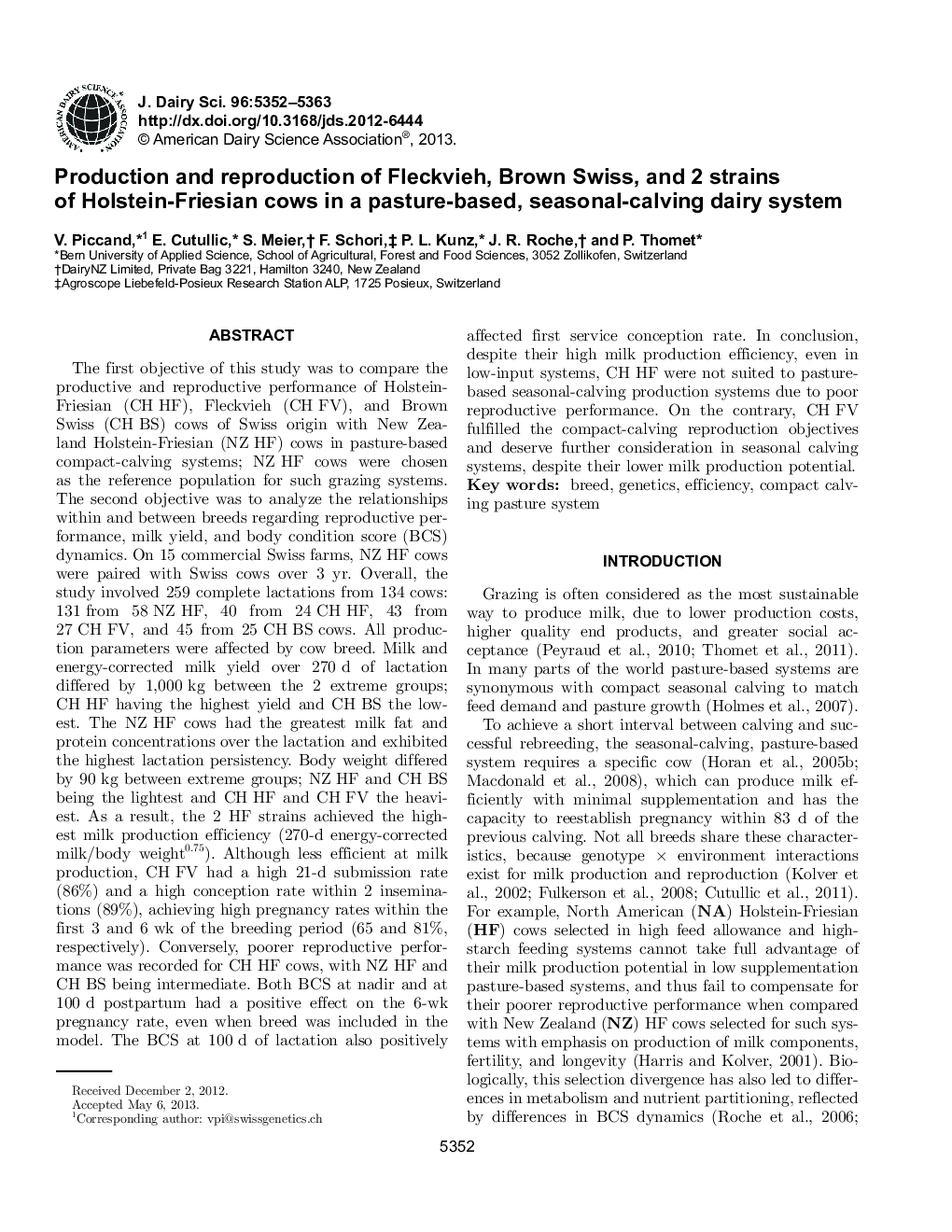| کد مقاله | کد نشریه | سال انتشار | مقاله انگلیسی | نسخه تمام متن |
|---|---|---|---|---|
| 2438914 | 1108051 | 2013 | 12 صفحه PDF | دانلود رایگان |
عنوان انگلیسی مقاله ISI
Production and reproduction of Fleckvieh, Brown Swiss, and 2 strains of Holstein-Friesian cows in a pasture-based, seasonal-calving dairy system
دانلود مقاله + سفارش ترجمه
دانلود مقاله ISI انگلیسی
رایگان برای ایرانیان
کلمات کلیدی
موضوعات مرتبط
علوم زیستی و بیوفناوری
علوم کشاورزی و بیولوژیک
علوم دامی و جانورشناسی
پیش نمایش صفحه اول مقاله

چکیده انگلیسی
The first objective of this study was to compare the productive and reproductive performance of Holstein-Friesian (CH HF), Fleckvieh (CH FV), and Brown Swiss (CH BS) cows of Swiss origin with New Zealand Holstein-Friesian (NZ HF) cows in pasture-based compact-calving systems; NZ HF cows were chosen as the reference population for such grazing systems. The second objective was to analyze the relationships within and between breeds regarding reproductive performance, milk yield, and body condition score (BCS) dynamics. On 15 commercial Swiss farms, NZ HF cows were paired with Swiss cows over 3 yr. Overall, the study involved 259 complete lactations from 134 cows: 131 from 58 NZ HF, 40 from 24 CH HF, 43 from 27 CH FV, and 45 from 25 CH BS cows. All production parameters were affected by cow breed. Milk and energy-corrected milk yield over 270 d of lactation differed by 1,000Â kg between the 2 extreme groups; CH HF having the highest yield and CH BS the lowest. The NZ HF cows had the greatest milk fat and protein concentrations over the lactation and exhibited the highest lactation persistency. Body weight differed by 90Â kg between extreme groups; NZ HF and CH BS being the lightest and CH HF and CH FV the heaviest. As a result, the 2 HF strains achieved the highest milk production efficiency (270-d energy-corrected milk/body weight0.75). Although less efficient at milk production, CH FV had a high 21-d submission rate (86%) and a high conception rate within 2 inseminations (89%), achieving high pregnancy rates within the first 3 and 6 wk of the breeding period (65 and 81%, respectively). Conversely, poorer reproductive performance was recorded for CH HF cows, with NZ HF and CH BS being intermediate. Both BCS at nadir and at 100 d postpartum had a positive effect on the 6-wk pregnancy rate, even when breed was included in the model. The BCS at 100 d of lactation also positively affected first service conception rate. In conclusion, despite their high milk production efficiency, even in low-input systems, CH HF were not suited to pasture-based seasonal-calving production systems due to poor reproductive performance. On the contrary, CH FV fulfilled the compact-calving reproduction objectives and deserve further consideration in seasonal calving systems, despite their lower milk production potential.
ناشر
Database: Elsevier - ScienceDirect (ساینس دایرکت)
Journal: Journal of Dairy Science - Volume 96, Issue 8, August 2013, Pages 5352-5363
Journal: Journal of Dairy Science - Volume 96, Issue 8, August 2013, Pages 5352-5363
نویسندگان
V. Piccand, E. Cutullic, S. Meier, F. Schori, P.L. Kunz, J.R. Roche, P. Thomet,